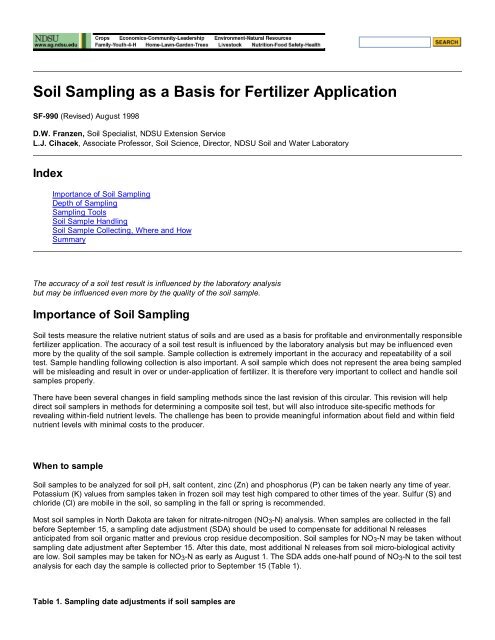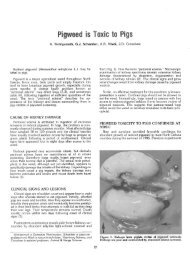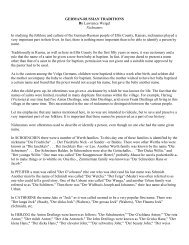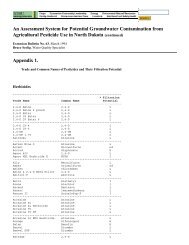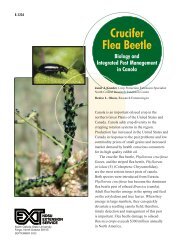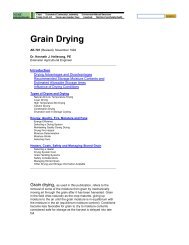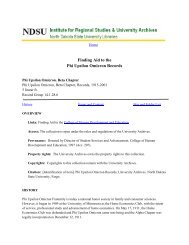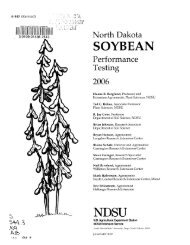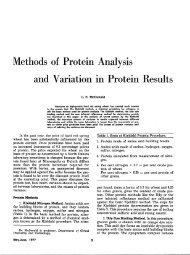Soil Sampling as a Basis fo...
Soil Sampling as a Basis fo...
Soil Sampling as a Basis fo...
You also want an ePaper? Increase the reach of your titles
YUMPU automatically turns print PDFs into web optimized ePapers that Google loves.
SF-990 (Revised) August 1998<br />
D.W. Franzen, <strong>Soil</strong> Specialist, NDSU Extension Service<br />
L.J. Cihacek, Associate Professor, <strong>Soil</strong> Science, Director, NDSU <strong>Soil</strong> and Water Laboratory<br />
Index<br />
Importance of <strong>Soil</strong> <strong>Sampling</strong><br />
Depth of <strong>Sampling</strong><br />
<strong>Sampling</strong> Tools<br />
<strong>Soil</strong> Sample Handling<br />
<strong>Soil</strong> Sample Collecting, Where and How<br />
Summary<br />
The accuracy of a soil test result is influenced by the laboratory analysis<br />
but may be influenced even more by the quality of the soil sample.<br />
Importance of <strong>Soil</strong> <strong>Sampling</strong><br />
<strong>Soil</strong> tests me<strong>as</strong>ure the relative nutrient status of soils and are used <strong>as</strong> a b<strong>as</strong>is <strong>fo</strong>r profitable and environmentally responsible<br />
fertilizer application. The accuracy of a soil test result is influenced by the laboratory analysis but may be influenced even<br />
more by the quality of the soil sample. Sample collection is extremely important in the accuracy and repeatability of a soil<br />
test. Sample handling <strong>fo</strong>llowing collection is also important. A soil sample which does not represent the area being sampled<br />
will be misleading and result in over or under-application of fertilizer. It is there<strong>fo</strong>re very important to collect and handle soil<br />
samples properly.<br />
There have been several changes in field sampling methods since the l<strong>as</strong>t revision of this circular. This revision will help<br />
direct soil samplers in methods <strong>fo</strong>r determining a composite soil test, but will also introduce site-specific methods <strong>fo</strong>r<br />
revealing within-field nutrient levels. The challenge h<strong>as</strong> been to provide meaningful in<strong>fo</strong>rmation about field and within field<br />
nutrient levels with minimal costs to the producer.<br />
When to sample<br />
<strong>Soil</strong> samples to be analyzed <strong>fo</strong>r soil pH, salt content, zinc (Zn) and phosphorus (P) can be taken nearly any time of year.<br />
Pot<strong>as</strong>sium (K) values from samples taken in frozen soil may test high compared to other times of the year. Sulfur (S) and<br />
chloride (Cl) are mobile in the soil, so sampling in the fall or spring is recommended.<br />
Most soil samples in North Dakota are taken <strong>fo</strong>r nitrate-nitrogen (NO 3 -N) analysis. When samples are collected in the fall<br />
be<strong>fo</strong>re September 15, a sampling date adjustment (SDA) should be used to compensate <strong>fo</strong>r additional N rele<strong>as</strong>es<br />
anticipated from soil organic matter and previous crop residue decomposition. <strong>Soil</strong> samples <strong>fo</strong>r NO 3 -N may be taken without<br />
sampling date adjustment after September 15. After this date, most additional N rele<strong>as</strong>es from soil micro-biological activity<br />
are low. <strong>Soil</strong> samples may be taken <strong>fo</strong>r NO 3 -N <strong>as</strong> early <strong>as</strong> August 1. The SDA adds one-half pound of NO 3 -N to the soil test<br />
analysis <strong>fo</strong>r each day the sample is collected prior to September 15 (Table 1).<br />
Table 1. <strong>Sampling</strong> date adjustments if soil samples are
taken in the fall prior to September 15.<br />
Date of sampling<br />
<strong>Sampling</strong> date adjustment<br />
lb NO 3 -N/acre<br />
August 1 23<br />
August 15 15<br />
August 30 8<br />
September 5 5<br />
September 15 0<br />
Producers should not be reluctant to sample in early August <strong>fo</strong>llowing small grain harvest because of fear of greater N<br />
rele<strong>as</strong>e from organic matter and residues compared to late fall sampling. If yields were relatively high, the SDA adjustment<br />
represents potential N rele<strong>as</strong>e well. <strong>Sampling</strong> fields be<strong>fo</strong>re tillage also incre<strong>as</strong>es the reliability of the 0-6 inch soil core depth<br />
because of more uni<strong>fo</strong>rm soil conditions compared to tilled fields. Waiting to sample small grain fields until late fall<br />
incre<strong>as</strong>es the risk of N uptake by small grain regrowth, which may contain up to 100 lb N/acre. <strong>Sampling</strong> standing row<br />
crops <strong>fo</strong>r NO 3 -N is not recommended.<br />
Fall soil sampling results <strong>fo</strong>r NO 3 -N and S are similar in most years to spring sampling. However, warmer than normal<br />
winters <strong>fo</strong>llowed by an early spring combined with good soil moisture could incre<strong>as</strong>e NO 3 -N and S levels through organic<br />
matter and residue mineralization. Green sugarbeet leaves or other crop residues with relatively high N content may also<br />
contribute to early mineralization and incre<strong>as</strong>e spring NO 3 -N levels compared to a fall soil sampling. In sandy soils with<br />
high rainfall or snow-melt <strong>fo</strong>llowing a fall sampling, levels of NO 3 -N and S in the spring compared to a fall sampling may<br />
decre<strong>as</strong>e <strong>as</strong> nitrate and sulfate is leached out of the sampling zone. In most situations, however, fall sampling is a good<br />
guide to N and S application.<br />
Depth of <strong>Sampling</strong><br />
<strong>Soil</strong> sampling and analysis <strong>as</strong>sumes 2,000,000 lb/acre of soil from 0-6 inches in depth. This weight per unit volume (bulk<br />
density) <strong>as</strong>sumes a medium soil texture with some compaction typically <strong>fo</strong>und <strong>fo</strong>llowing cropping and harvest. Bulk density<br />
differences can make a difference of 10% in soil test results. Bulk density is ignored in commercial soil sampling, but<br />
consistency in soil sampling techniques is important because of soil bulk density differences, especially in surface cores.<br />
The depth of sampling required depends mainly on the nutrient of interest, the crop to be fertilized, and in some c<strong>as</strong>es, the<br />
tillage system in place (Figure 1).<br />
Figure 1. Depth recommended generally <strong>fo</strong>r soil analysis of certain<br />
properties and nitrate analysis <strong>fo</strong>r crops.<br />
<strong>Soil</strong> Surface <strong>Soil</strong> Properties Crops<br />
0-6 inch pH, P,K, OM, Cl, S, Ca, Mg,<br />
CEC, Zn, NH4 + -N, Fe, Mn,<br />
Cu, soluble salts, NA<br />
Alfalfa, clovers (analyze only<br />
0-6 inch depth, nitrate analysis<br />
at deeper depths not<br />
necessary).<br />
6-24 inch Soluble salts, NO 3 -N, S, Cl (in<br />
addition to 0-6 inch depth)<br />
Wheat, barley, oats, durum,<br />
corn, soybean, dry bean,<br />
potato, canola, crambe,<br />
mustard, sunflower, gr<strong>as</strong>s<br />
hay, p<strong>as</strong>ture, millet, canary<br />
seed, flax, safflower,<br />
buckwheat, lentil, field pea,
sorghum, sudangr<strong>as</strong>s.<br />
(Separate 0-24 inch depth into<br />
a 0-6 inch and 6-24 inch<br />
depth.)<br />
24-48 inch NO 3 -N, in addition to the 0-6<br />
inch and 6-24 inch depths<br />
Sugarbeet, malting barley.<br />
(Sunflower if greater than 30<br />
lb N/acre are anticipated at the<br />
24-48 inch depth.) (Separate<br />
cores into 0-6 inch, 6-24 inch<br />
and 24-48 inch depths.)<br />
Nutrients<br />
For soil pH, P, K, Zn, copper (Cu) and manganese (Mn), sampling the 0-6 inch depth is adequate. In long-term no-till<br />
fields, soil pH, P, and K may become stratified. Most studies <strong>fo</strong>r P and K suggest that stratification is not important <strong>as</strong> long<br />
<strong>as</strong> the fertilizer P and K rates b<strong>as</strong>ed on a 0-6 inch value is <strong>fo</strong>llowed. However, soil pH may be important in the surface 0-2<br />
inch layer because of possible herbicide interaction with lower pH levels. The 0-6 inch depth is also important <strong>fo</strong>r soluble<br />
salts, in addition to the 6-24 inch depth.<br />
To determine soil NO 3 -N, S and Cl, samples are taken from at le<strong>as</strong>t the 0-24 inch depth. The 0-24 inch sample should be<br />
broken into a 0-6 inch depth and a 6-24 inch depth, so that the relative position of N in the soil can be determined. In some<br />
years, NO 3 -N can be leached to lower depths so that large amounts are in the 6-24 inch layer but only a small amount may<br />
be left in the 0-6 inch layer. Depending on the crop, soil NO 3 -N may need to be determined on the 24-48 inch depth (2-4<br />
<strong>fo</strong>ot) also. A few are<strong>as</strong> within the Red River Valley have a history of poor sugarbeet quality due in part to the presence of<br />
especially high levels of soil NO 3 -N at deep depths. In these special are<strong>as</strong>, deep N to 6 feet may also need to be checked.<br />
Crop<br />
For most crops, NO 3 -N should be determined on the 0-24 inch depth. For sugarbeet and malting barley, the 24-48 inch<br />
depth should also be sampled to fine-tune N rates necessary to improve beet and grain quality. Sunflower also may use<br />
deep N; however, deeper sampling is conducted not to improve quality, but to save money on N fertilizer when there is<br />
re<strong>as</strong>on to suspect the presence of large quantities of N at deep depths, such <strong>as</strong> <strong>fo</strong>llowing years of growing shallow rooted<br />
crops, <strong>fo</strong>llowing fallow, and when previous crop yields have been low.<br />
Tillage system<br />
Under conventional tillage and conservation tillage, sampling 0-6 inch, 6-24 inch and the 24-48 inch depths described<br />
previously are appropriate. Under long-term no-till, stratification of soil non-mobile nutrients and soil pH will occur.<br />
Phosphate and soil pH stratification are common, with high P and lower pH levels at the surface 0-2 inch depth and lower P<br />
and higher pH levels at deeper depths. If the lower depths become depleted in P, application of more deeply placed P may<br />
be beneficial, especially in drier se<strong>as</strong>ons. <strong>Soil</strong> pH tends to become acid at the surface, especially if N fertilizers are applied<br />
to the surface. Separating the 0-6 inch depth into a 0-2 inch depth and 2-6 inch depth would identify these trends (Figure<br />
2).<br />
Figure 2. <strong>Sampling</strong> under special tillage conditions.<br />
Ridge till<br />
No till <strong>fo</strong>r soil pH and P<br />
if stratification from long-term<br />
no till is suspected
Sample is obtained straight<br />
downwards,<br />
6 inches from the ridge center<br />
The 0-6 inch core is separated<br />
into a 0-2 inch and 2-6 inch depth<br />
<strong>fo</strong>r soil pH and P<br />
Special sampling situations<br />
Ridge-till is occ<strong>as</strong>ionally used in North Dakota, but it is a popular tillage system in some are<strong>as</strong> of the corn-soybean belt. In<br />
ridge till, ridges are built by deep cultivation during the growing se<strong>as</strong>on and remain in the field <strong>fo</strong>llowing harvest and<br />
through the winter. At planting, the top of the ridge is removed, exposing moist soil <strong>fo</strong>r seeding, and soil from the top of the<br />
ridge is moved into the row middles. Starter fertilizer is often used at planting, and sometimes deep-placed fertilizer is<br />
applied right under the ridge-top in the fall. Ridge-till should be sampled 6 inches to either side of the ridge-top and straight<br />
down into the ridge (Figure 2).<br />
Fields with a history of large band applications of P and K are special problems, especially where within-field P and K levels<br />
are to be determined. When band rates greater than about 30 lb P 2 O 5 or K 2 O are used, there may be a residual effect of<br />
the fertilizer band <strong>fo</strong>r several years. If the bands can be located, they should be avoided when sampling. In North Dakota,<br />
high reproducibility of P levels h<strong>as</strong> been achieved in grids or zones using eight to 10 soil cores where 20-30 lb P 2 O 5 h<strong>as</strong><br />
been applied annually. For sampling whole fields, the 20 cores per field recommendation is appropriate.<br />
| more |<br />
SF-990 (Revised) August 1998<br />
County Commissions, North Dakota State University and U.S. Department of Agriculture cooperating. North Dakota State University does not<br />
discriminate on the b<strong>as</strong>is of race, color, national origin, religion, sex, gender identity, disability, age, status <strong>as</strong> a U.S. veteran, sexual orientation, marital<br />
status, or public <strong>as</strong>sistance status. Direct inquiries to the Vice President <strong>fo</strong>r Equity, Diversity and Global Outreach, 205 Old Main, (701) 231-7708. This<br />
publication will be made available in alternative <strong>fo</strong>rmats <strong>fo</strong>r people with disabilities upon request, 701 231-7881.<br />
In<strong>fo</strong>rmation <strong>fo</strong>r Prospective Students<br />
NDSU is an equal opportunity institution<br />
This in<strong>fo</strong>rmation may be photocopied <strong>fo</strong>r noncommercial, educational purposes in its entirety with no changes.<br />
Requests to use any portion of the document should be sent to NDSU.permission@ndsu.edu.<br />
North Dakota State University Agriculture and University Extension<br />
Dept. 7070, Morrill 7, P.O. Box 6050, Fargo, ND 58108-6050


